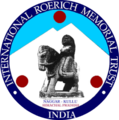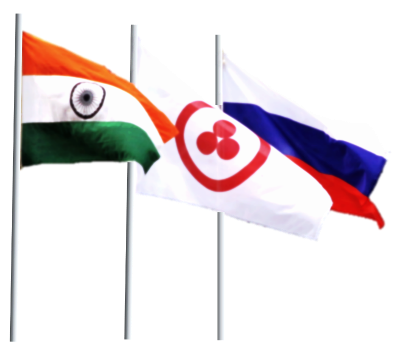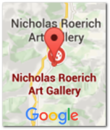05.05.2024
Round Table "Roerichs: Heralds of Culture"
On 6 May, the International Roerich Memorial Trust hosted a Round-table discussion with scholars, researchers, artists and festival guests at the traditional Spring Festival, this year dedicated to the theme "Roerichs: Heralds of Culture".
Russian Curator Larisa Surgina spoke on the theme of the Round Table - "Roerichs: Heralds of Culture". For the Roerichs, culture was not something secondary, not a superstructure or unnecessary atavism, but the basis of life, the foundation on which civilization is built. For them, the concepts of culture and civilization were separate: civilization is those utilitarian values that man creates for his own convenience, while culture is that which nourishes the human spirit. Civilisation is impossible without culture - it is a dead end. Today it is particularly important to realise the depth of the concept of culture in Roerich's work. Nicholas Roerich described culture as a trinity of beauty, knowledge and love, or art, science and religion or philosophy - in both cases culture is presented as a link with the higher world. Only culture can unite humanity - the artist's motto was the idea of peace through culture. Nicholas Roerich noted the importance of both science and art and remarked that experimental science should come closer to the science of the spirit. Mrs. Larisa Surgina noted that the Round Table presentations will reflect this idea: they will include reports from scientists who are engaged in scientific research at the interface with meta-science, as well as from artists and specialists in the humanities.
The first speakers were Irina Arkhipova, Cultural Ambassador of the Women’s Union of Russia, General Director of the historical film studio "Pharaoh" (St. Petersburg, Russia), organiser of the annual international research expedition "Himalaya"; and scientist Rinad Minvaleev, physiologist, candidate of biological sciences, associate professor of St. Petersburg State University. For many years the speakers have been conducting research expeditions, the purpose of which is a comprehensive study of the method of increasing the cold resistance of a person, developed by scientists of St. Petersburg State University: Rinad Minvaleev and mathematician, Candidate of Physiological Sciences A. Ivanov on the basis of Tibetan yoga Tummo. In her part of the speech Irina Arkhipova shared that many years ago Nicholas Roerich's book "The Heart of Asia" became a source of her inspiration, prompting her to make her first journey to India, and later - to become an organiser of research expeditions to the Himalayas, which have been held under her leadership for 20 years. The expeditions are accompanied by scientists who carefully document the results and collect the necessary data for further research. Rinad Minvaleev, the creator of the method of increasing human cold tolerance based on Tibetan Tummo practices, presented the scientific rationale for the method and research results obtained during previous expeditions. Scientists have established and published in peer-reviewed scientific periodicals that the combination of high-altitude hypoxia with cold testing provides the highest rate of anti-atherogenic changes in serum lipid profile in relatively healthy subjects (effective prevention of atherosclerosis). A controlled reduction of stress hormones during cold exposure has been achieved (stress management). Haemodynamic mechanisms of increasing cold tolerance in humans have been found. Vegetative markers of successful high-altitude adaptation are revealed. Irina Arkhipova noted the importance and relevance of the ongoing research for athletes and military personnel."
The work of the Festival was opened by the curators of the IRMT. The Indian Curator, Mr Suresh Kumar, welcomed the guests and participants of the Round Table. He reminded that this year is the jubilee year of Nicholas, Helena and Svetoslav Roerich. The Roerichs' contribution to cooperation and cultural exchange between Russia and India is invaluable. At the Roerichs' estate, a fruitful interaction between artists, scientists and musicians is taking place with the active participation of the Russian Embassy in India, the International Center of the Roerichs, Moscow, the Kullu Administration, Himachal Pradesh Government and the staff of the Trust. The International Roerich Memorial Trust in Naggar has become the centre of this cooperation, which is important not only for the entire state, but also for Russian-Indian relations and mutual friendship. The Government of India recognised Nicholas Roerich's contribution to the development of culture and decided to name a street after him in the Indian capital, Delhi.
The next speaker at the Round Table was a young Indian artist from Mumbai - Dev Chandra. The session was held amidst the artist's paintings so that the participants could appreciate the brevity and depth of his works, which depict the sacred Indian Himalayas in their midnight beauty - the exhibition of the artist's works is called "Himalayan Nights". Dev Chandra shared with the audience the story of his introduction to the work of Nicholas Roerich, which shocked and fascinated the young artist and completely changed his life. It was through Roerich's paintings that he discovered the beauty of the Himalayas, and like many other Indian artists who were drawn to the beauty of the Himalayas through Roerich's paintings, he himself became a singer of the beauty of the mountain peaks. The artist was also greatly influenced by Nicholas Roerich's humanistic ideas. He noted that in our world, full of wars and destruction based on selfishness, Roerich's ideas about peace through Culture and the protection of cultural values seemed particularly important and relevant to him. The artist said that one of the objectives of his exhibition, which is touring Indian cities, is to acquaint the public with the ideas of Nicholas Roerich.
The first part of the Round Table ended with a report by Olga Karaseva, a doctoral student at Jawaharlal Nehru University (Delhi), a researcher at the United Centre for Cosmic Thinking of the International Centre of the Roerichs (Moscow), who focused on the concept of culture in the works of Nicholas Roerich. The artist understood culture as a kind of chronicle of human achievements, an energy, an information field, which, through cultural objects, through the work of many generations, is able to interact with modernity, to guide mankind, to inspire new creativity for the benefit of the world. The most important direction of Roerich's activity in the years before the Second World War was the promotion of the idea of the need to protect cultural values both in times of war and in times of peace. Years of tireless work by the artist were embodied in the document known to history as the Roerich Pact. The Roerich Pact is based first and foremost on people's awareness of the need to preserve culture for future generations. Unfortunately, society was not ready for such a responsibility, nor was it ready to understand the artist's idea of the unity of culture beyond the borders of states, class and race. It was in the 20s and 30s that chauvinism flourished in the countries of Europe. This phenomenon was one of the reasons why the Roerich Pact was unfortunately not universally supported and applied in life. Putting Roerich's ideas into practice required states and peoples to make a conscious choice in favour of preserving cultural values and building a future based on the principles of ethics and morality. Nicholas Roerich's ideas about the importance of culture and the protection of cultural values are particularly relevant today.
Ms. Galina Stepanova, a well-known Russian artist, owner and founder of the Petersburg Artist Museum and Exhibition Centre, spoke next about her experience of restoring one of the cultural monuments of federal significance in private hands - the Maryino Manor, of which she is the owner. The report raised the issue of the need to preserve, restore and utilise cultural monuments. At present, Maryino is one of the examples of successful restoration, preservation and functioning of a state monument without state involvement. Galina Stepanova took great care to recreate the atmosphere of a traditional Russian manor of the 19th century. Staying in the manor takes visitors to the atmosphere of lavish balls, beautiful rooms and halls - each with its own history - and horse rides in the large park. There are always festivals and celebrations at the manor, including costume festivals, during which the owners and guests dress up in the outfits of the respective epoch. The economy of the estate is organised in such a way as to ensure the upkeep of the estate. After the report, Galina Stepanova and the festival participants discussed the need for government involvement in such projects. Unfortunately, it is minimal at the moment. Owners of estates like Maryino have to find their own funds to restore and maintain historical monuments. Larisa Surgina, the Russian curator of the IRMT, recalled the Roerich Pact for the Protection of Cultural Monuments. The Pact has been signed by many states, but it is up to the public to put it into practice. Unfortunately, states will not take the initiative without public activity, without drawing the public's attention to the protection of cultural values. The public should be the driving force behind culture, and the state should help, or at least not hinder.









Yuri Babushkin, a well-known sculptor from the Far East, was next to speak. He told the story of his creative journey - from scientist-physicist and physics teacher to the head of Amrita, a creative bone carving workshop. In a sense, Mr Babushkin has managed to combine the mind of a scientist with the creative eye of an artist. In this regard, the roundtable participants recalled Svetoslav Roerich's famous statement that the man of the future will combine the mind of a scientist, the vision of an artist and the heart of a thinker.
At the end of the round table there was a report by Anatoly Lebedenko, candidate of pedagogical sciences, senior researcher of the United Centre for Cosmic Thinking of the International Centre of the Roerichs (Moscow), who told about the experience of Svetoslav Roerichs' creation of the Sri Aurobindo Ghosh School in Bangalore. To direct the consciousness of the youth towards the beautiful future is the task of a true school. The Roerichs' concept of educating a noble man is the Living Ethics, the way of consciously creating the leading magnet of beauty under the Banner of Peace, the Banner of Culture. The Art Boarding School was founded in 1967. It was characterised by the fact that the educational process was based on moral teaching and the establishment of ethical principles. "We try from the very beginning to guide the young generation on the path of ascent," said Svetoslav Roerich. Teachers direct students as much as possible towards self-education and self-improvement, so that children can discover and realise their own way of achieving the ideals of beauty. The school pays special attention to the development of manual and artistic skills. From an early age, the children embroidered fabrics, made mosaics, designed, learned dance, music and musical instruments. Svetoslav Roerich emphasised the importance of a teacher, a mentor in a person's life. He said that for him his parents, Helena and Nicholas Roerich, were the true example of teachers of life. In his educational projects, Svetoslav Roerich always tried to pass on to his students the high moral ideals of the Roerich family.
The Round Table concluded with a greeting from School No. 49 of Vladimir city (Russia), during which students discussed their experience of developing an educational process based on Roerich's principles and ideas. Pupils of the school presented information about exhibitions of the artist's works and permanent exhibitions devoted to Russian antiquity, the Roerich Pact and the protection of cultural values. The participants expressed their hope that they would be able to establish contacts with Indian schoolchildren, share their experience and adopt the experience of Indian schoolchildren. The presentation concluded with a life-affirming song performed by the school's choir.
At the end of the Round Table, participants exchanged comments and impressions and continued the informal and friendly conversation over tea and treats in honour of the Easter holiday.






















